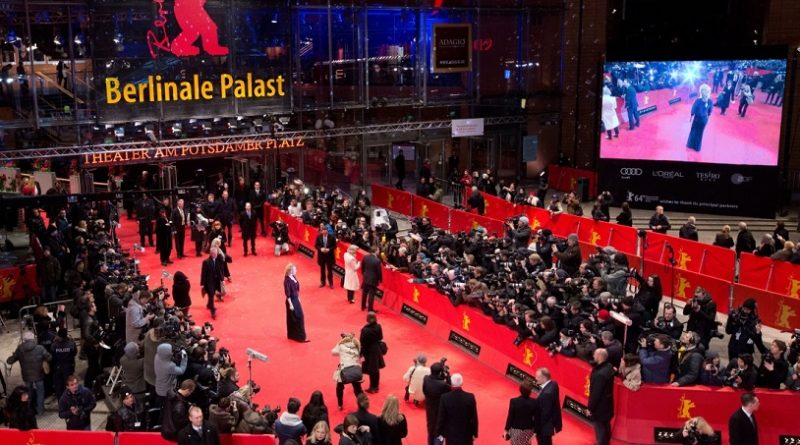Digital Cinema at Berlinale 2016 – Digitales Kino auf der Berlinale 2016
Over the course of the past six years, the Berlin International Film Festival has grown to be one of the biggest technological trailblazers on the film festival scene – thanks in no small part to the support of its Digital Cinema Partners. As a result, in the scope of the increasing digitization of the cinema world, since 2010 all of the Berlinale’s cinemas have been successively connected to the festival’s Film Office via a fibre optic network, a completely new workflow for the inspection and administration of the submitted films has been established and a central storage system with over one petabyte (1000 TB) in storage capacity has been set up to accommodate the film files.
The Berlinale is continuing this development in 2016 and is once again supported in its efforts by Colt Technology Services, Rohde & Schwarz DVS, ARRI, Dolby, Barco and Aspera, an IBM company.
One significant new development in this regard is an even more intense employment of the data transfer software Faspex from Aspera. In combination with a high-speed Colt Internet connection running at 10 gigabits per second, the software enables film production teams from all across the world to upload their film files directly to the Berlinale server. This welcome change has made the time-consuming shipment of physical hard drives containing DCPs (digital cinema packages), each with an average individual size of 180 GB, obsolete.
The Berlinale Film Office was already able to take advantage of this technology for its selection screenings for the 66th edition of the Berlinale, receiving over 100 films in DCP format securely through the Internet in the run-up to the festival.
Over 95% of the more than 2,500 screenings will be shown digitally in the DCP format – analogue screenings are only taking place on an individual basis, for the most part in the Retrospective and Homage sections. In the Berlinale Palast, the festival is equipped for film screenings in the immersive sound format Dolby Atmos, thanks to the support of Dolby.
A further milestone this year is the use of a 4K laser projector from Barco in the Friedrichstadt-Palast. This new laser technology enables the Berlinale to bring especially high-contrast and bright images to the venue’s 22-meter-wide screen.
“The support of our technological partners is of particular significance for the Berlinale. They enable the festival to make use of the newest technologies for the distribution and projection of our films,” as Festival Director Dieter Kosslick commented.
Press Office
February 18, 2016
***
Digitales Kino auf der Berlinale 2016
In den letzten sechs Jahren konnten sich die Internationalen Filmfestspiele Berlin – nicht zuletzt durch die Unterstützung der Digital Cinema-Partner – zu einem technologischen Vorreiter unter den Filmfestivals entwickeln. So wurden im Zuge der Digitalisierung des Kinos seit 2010 sukzessive alle Berlinale-Kinos per Glasfasernetzwerk mit dem Film Office der Berlinale verbunden, es wurde ein vollkommen neuer Workflow für die Prüfung und Verwaltung der angelieferten Filme etabliert und ein zentrales Speichersystem mit über ein Petabyte (1000 TB) Speicherplatz für Filmdaten eingerichtet.
Auch 2016 setzt die Berlinale diese Entwicklung fort und wird dabei erneut von Colt Technology Services, Rohde & Schwarz DVS, ARRI, Dolby, Barco und Aspera, an IBM company unterstützt.
Eine einschneidende Neuerung ist dabei die noch intensivere Nutzung der Datenübertragungs-Software Faspex von Aspera. In Kombination mit einer 10 Gigabit/Sek schnellen Colt-Internet-Anbindung ermöglicht die Software den Filmproduktionen aus aller Welt die direkte Anlieferung der Filmdaten auf die Berlinale-Server. Ein zeitaufwändiger Versand der im Schnitt 180 GB großen DCPs (Digital Cinema Packages) auf Festplatten ist dadurch nicht mehr nötig.
Das Berlinale Film Office konnte diese Technologie bereits für die Auswahlsichtungen zur 66. Berlinale nutzen und im Vorfeld über 100 Filme im DCP-Format sicher über das Internet empfangen.
Über 95% der mehr als 2.500 Vorführungen werden digital im DCP-Format gezeigt – analoge Vorführungen finden nur vereinzelt und überwiegend in den Sektionen Retrospektive und Hommage statt. Im Berlinale Palast ist das Festival dank der Unterstützung von Dolby auf Filmvorführungen im immersiven Soundformat Dolby Atmos vorbereitet.
Ein weiterer Meilenstein ist in diesem Jahr der Einsatz eines 4K-Laser-Projektors von Barco im Friedrichstadt-Palast. Die neue Laser-Technologie ermöglicht es der Berlinale die 22 Meter breite Leinwand mit besonders kontrastreichen und lichtstarken Bildern zu bespielen.
„Die Unterstützung der Technik-Partner ist von besonderer Bedeutung für die Berlinale. Sie ermöglichen es dem Festival, zur Distribution und Projektion von Filmen auf neueste Technologie zurückgreifen zu können“, kommentiert Festivaldirektor Dieter Kosslick.




